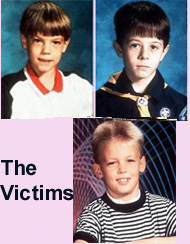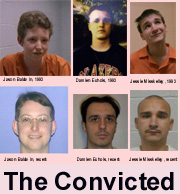Jivepuppi.com


Sequence
data from a hair from Moore's ligature.
A Twilight Kill, Part Eleven: DNA
DNA encodes our traits; we are distinct
individuals
because of the makeup of our DNA. In turn, our DNA can be used to
identify us. Present in tissues and secretions often found at crime
scenes including blood, semen and hair, it can be the ideal forensic
tool, the ultimate arbiter of innocence or guilt.
In this case, critical biological samples were taken
from the victims, from suspects and from the collected evidence. The
state and the appeals attorneys agreed to examine: fingernail scrapings
from the victims; tissue samples from the ligatures; swabs from
each victim; cuttings from their clothes; loose hairs recovered from
the victims including hairs found in the ligatures;
hairs found
on the victims clothing, the morgue sheets and at the crime scene; and,
several miscellaneous items.
Biological specimens were also obtained during the
investigation from 44 other suspects and family members for matches or
exclusion. These samples could also be examined in future tests.
DNA Results
In the DNA Status Report filed with the
appeals,
none of the DNA sequenced matched any of those in prison for the crime.
Almost all of the DNA from the crime scene matched the victims. Hairs
that previously had been found "microscopically similar" to those of
Damien Echols and Jason Baldwin did not come from them. The report went
on to say, "Although most of the genetic material recovered from the
scene was attributable to the victims of the offenses, some of it
cannot be attributed to either the victims or the defendants." [DNA
Status Report, July 17, 2007]
Partial results found nuclear DNA belonging to
neither the victims nor the convicted on the penile swabs from Stevie
Branch and Michael Moore suggestive of criminal contact. Hair shafts
only contain mitochondrial DNA. The convicted were excluded as the
source of any of the hairs. The following six hairs each had different
individual profiles, not matching the victims or those in prison:
- Hair from Michael
Moore ligature
- Hair from Chris
Byers ligature
- Negroid hair
fragment, morgue sheet
- Hair from scout
cap (only partial sequence available)
- Hair from tree
stump
- Dyed hair from
sheet used to cover Chris Byers
The hair from
Michael Moore ligature had a single nucleotide change from the
mitochondrial DNA of a sample gathered from the home of Terry Hobbs -
the stepfather of the victim, Stevie Branch. With a single nucleotide
difference, he can not be excluded as a possible source. Stevie
Branch's mother, Pamela Hobbs, says
she believes her ex-husband may have committed the crime and has come out in favor of a retrial.
Some material failed to amplify, including those
from the Kershaw knife and a hair from Michael Moore's pants.
The exclusion of the convicted as sources of the
material gathered from the crime scene is powerful evidence of their
innocence. Someone else left DNA on the penises of Michael Moore and
Stevie Branch indicative of a sexual crime. Notably, Chris Byers had
his genitals mutilated and could not be thus tested. The hairs from the
ligatures of Moore and Byers may well point to the killer.
The Power - and Impotency of DNA Fingerprinting
Through methods that can match even small
amounts of
genetic material to the person who deposited it, DNA has become a
torchlight illuminating the deficiencies of our judicial process.
Convictions based on eyewitness identification, hair "matching,"
jailhouse snitches, even confessions to police have been
found lacking.
In the first application of DNA fingerprinting, the
police had the confession of 17-year old Raymond Buckley for murder and
rape. Suspecting the same perpetrator was guilty in a second case, they
tested his DNA versus semen gathered from the two cases. The police
were half-right: the cases were the same perpetrator, but not Buckley.
Eventually they matched the DNA to the true killer.
Even when DNA excludes a convict the judicial
process often turns a blind eye. Clarence Elkins was convicted of the
rape and murder of his mother-in-law. After years in prison, the DNA
from the semen left in the victim was shown to be someone else's.
An evidentiary hearing was called. Elkins was denied a new trial.
Returning to prison, he encountered a fellow inmate who was a rapist
and a neighbor of the victim. He pocketed some discarded cigarette
butts from the man and sent them to his family so they could get a DNA
fingerprint from the saliva secretions. The DNA matched, as did a more
properly obtained sample.
A ridiculous standard was set for Elkins - he had to
find the killer himself while in prison. The judicial process is
negligent in admitting its mistakes. They would have to admit
complicity in half-baked verdicts that relied on prejudices and
strained evidence. Although there are seldom financial judgments in
favor of those proven wrongfully convicted, a fear of lawsuits can
drive self-interest over that of justice. Besides, for the authorities
involved, it is not their own lives they are throwing away.
Horrific crimes arouse fears and prejudices we
normally lock away in a deep vault of our minds. Unleashed, reason is
banished. In this case, there was not a piece of evidence that wasn't
compromised or stretched beyond reason. The tainted and contrived
evidence, the lies and last minute revelations, the compromised and
flawed witnesses were not coincidental. The state was trying to make a
case that just didn't fit the suspects. DNA, science and reason do not
point toward the convicted. DNA evidence is impotent in the face of
willful ignorance.
- Two bands, not
matching
Stevie Branch's DNA, were present on the sperm fraction from the penile
swab. D16S539, bands 8, 11.
- A single
additional band,
not matching Michael Moore's DNA, was present in the nonsperm fraction
from the penile swab on Michael Moore. D5S818, band
12.
A single suspect with these three
bands would make a likely candidate to be the killer.
Continued in A Twilight Kill, Part Twelve: Whodunnit.











